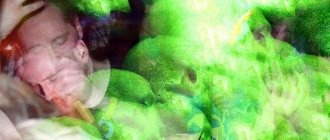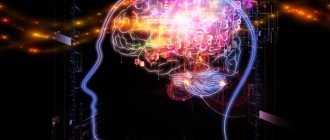Consciousness as a subject of psychology
The founder of scientific psychology is Wilhelm Wundt. Wundt was a major scientist and studied various fields: philosophy, physiology, physics, etc. In the mid-70s, he won 4 rooms from his superiors, and around 1875 the department opened. And in 1879, this department began to be called the institute, because students were admitted there for the first time. That is why 1879 is considered the year the birth of psychology.
For Wundt, the subject of research was consciousness, and the method of research was introspection. Wundt wanted to build psychology as a natural science discipline. And then he defines psychology from three sides: psychology is the science of the properties of consciousness (1), the elements of consciousness (2) and the connections between them (3).
Based on his research, Wundt identifies the first property of consciousness - organization, structure. Consciousness is the structure of organized elements. Elements of consciousness are objective and subjective.
In Wundt's terminology, the single objective element of consciousness is a simple impression. A simple impression means that it cannot be decomposable into smaller units, a kind of indivisible atom.
An indivisible element of consciousness is sensation. For example, a sensation is the simple impression that occurs when we hear a single beat of a metronome. And if there are two hits or more, then this is already a performance. Sensations and ideas are objective elements of consciousness.
Subjective elements of consciousness are elements associated with the subject himself. Subjective means internal, coming from myself. The subjective elements of consciousness are feelings (emotions).
Wundt divides feelings and emotions according to three parameters, which were formed based on the results of the subjects’ reports.
- Pleasure - displeasure. For example, when a subject is asked to listen attentively and identify a separate beat of the metronome, then at this moment he most likely experiences displeasure.
- Excitement - calm. Wundt says that feelings never appear as something independent. A feeling or emotion is always an attitude towards some object. Likewise, excitement-calm does not appear on its own, but is a sensory coloring of some impression. For example, the sensory coloring of an impression when perceiving color. We perceive red - we experience excitement, blue - calm, purple - depression.
- Voltage - discharge. When a person expects the metronome to sound, this expectation causes emotional tension. And when the event occurs, there is a release.
As already mentioned, consciousness is organized. Elements in the field of consciousness form connections; they are structured. Thus, the field of consciousness is a structure, and in the center of this structure there is a central point - this is what we are currently paying attention to. This focal point, the focus of attention, is also surrounded by a certain area. We can say that around this focal point there is a central part of the field of consciousness, which is called the field of attention.
Wundt established that this field of attention is limited. The number of elements in the field of attention (which a person can hold in the center of consciousness) has a limit: from 3-4 to 6 elements. In the 20th century, these figures were changed to 7±2.
Views
Philosophy raised questions of soul and body, material and mental, it studied the soul, mind and subjective experience, as well as its connection with the material world. A brief description of several interesting theories formulated during the controversy:
1. The most striking is the theory of the eliminativist. According to it, subjective experience is not necessarily present at all. We invent our own world, and everyone has their own psychological reality. The authors of this concept propose to rely on neuroscience, which, bypassing the conscious mind, will fully describe the functioning of the brain and its control of our actions.
The concept of consciousness is too vague, in their opinion. The observer only notices brain activity and behavior on the other hand. Conscious experience exists as a subjective phenomenon, even if the observer does not see it, but the person himself is confident in it. The views of eliminativism are actively criticized, and the theory of reductive materialism is more recognized.
2. So-called reductive materialism believes that brain = conscious experience, neural activity = subjective experience. In essence, he denies the existence of a separate psychological level.
3. Scientists see great promise in emergent materialism, which postulates the idea that conscious experience is a new level of reality that arises as a result of the complex organization of many subsystems. Revonsuo compares the conscious flow of experiences with another, also emergent phenomenon - life. For a long time, life was considered to be something different from the ordinary physical world, but as science progressed, it became clear that nothing nonphysical was required to explain life.
The origin of consciousness is associated with the origin of society, i.e. its formation can be attributed to approximately the last ten thousand years of human existence. Apparently, the main role in the emergence of consciousness was played by the joint activity of people. It is difficult to say exactly what processes served as a catalyst for its occurrence.
We recommend: Higher mental functions
Perhaps the need to organize common work with the establishment of a specific goal. Some researchers believe that it arises at the moment of imagination. The individual, according to other scientists, began to form three thousand years ago, and before that man lived in a psychedelic reality, where his behavior was controlled by hallucinations (hence the myths and legends about gods, etc.).
The origin and essence of consciousness are thus still unclear. This is one of the most attractive and secret areas of psychology. The discovery of the nature of the conscious flow of experiences is possible only with the development of neuroscience.
Sentences with the word consciousness
Our robot made several proposals automatically. Evaluate his work, thereby you will help him become more perfect.
1. Consciousness began in detail with a slight rustling
0
0
2. At the same time, consciousness sharpened without a deadening necessity
0
0
3. Selfish consciousness reigned in the everyday swamp
0
0
4. Consciousness regally objected to the nearby tape recorder
0
0
Declension of the noun consciousness (which case)
Declension of words by case in singular and plural.
| Case | Question | Unit | Mn. number |
| Nominative | (who what?) | consciousness | consciousness |
| Genitive | (who, what?) | consciousness | consciousnesses |
| Dative | (to whom; to what?) | consciousness | consciousnesses |
| Accusative | (who, what?) | consciousness | consciousness |
| Instrumental | (by whom, what?) | consciousness | consciousnesses |
| Prepositional | (About who about what?) | consciousness | consciousnesses |
Scope of use
Archaism Book expression Media Phraseologism Military-political term
Theory
No matter how we look at it and from what position we approach it, consciousness and self-awareness are always nearby. Without reflection it would be impossible to discover consciousness. Other characteristics of consciousness can be identified.
- Awareness of oneself as a subject.
- Goal setting (imagination, behavior control, self-management).
- Use of words and concepts.
- Cognitive processes and evaluative attitudes.
Speech and consciousness are closely connected; the latter does not exist without speech in higher forms, since thanks to it a system of meanings and meanings is formed. Verbal and figurative are the main forms of consciousness.
The levels of human consciousness fit into the following scheme: awareness of the separateness of the world (one’s individuality, independence from the world), the development of reflection. Depending on how a person acts in the world and perceives it, types of consciousness are distinguished: everyday (operating with things), project (active, goal and its implementation), scientific (abstraction, research, healthy skepticism), aesthetic (emotional perception), ethical.
The psychological structure of consciousness consists of thinking, will, emotions, self-awareness, memory, imagination. The functions of consciousness correspond to its characteristics and structure: reflection and control. The reflective function is indicated directly in the definition, while the control function is often criticized on the basis of experiments (when the subject presses the button before realizing it).
The problem of consciousness in psychology, therefore, is still acute. The specific features of consciousness (the subjectivity of the experience of the conscious) do not make it possible to directly study it. Metzinger's book describes an interesting experiment with an “alien” hand, when a person can do something that he did not consciously decide to do for himself, in conditions of insufficient concentration. This means that at any moment, any of our actions can be one of the unconscious impulses, and the only way not to succumb to seduction is to be conscious. Author: Ekaterina Volkova
CONSCIOUSNESS IS PRIMARY, AND MATTER IS SECONDARY - SCIENTISTS PROVED
The age-old debate about what comes first—consciousness or matter—has finally been resolved, and not in favor of the materialists. A cascade of the latest scientific discoveries by Nobel laureates Paul Davis, David Bohm and Ilya Prigogine has shown that, delving deeper into matter, you are faced with facts of its complete disappearance.
Swiss scientists from the European Center for Nuclear Research (CERN) went even further: they managed to simulate the “moment of creation” of matter from the non-material world. Experts have experimentally proven that a portion (quantum) of virtual waves, under certain conditions, forms certain particles, and with another interaction of the same waves, the particles completely disappear. Thus, scientists were able to create a mini-universe from almost nothing.
This discovery proves that our world was indeed created from the void by some higher cosmic intelligence, or simply God.
By the way, with the help of retrospective modeling it was possible to calculate the age of the material Universe with an accuracy of a hundredth of a second.
It was only 18 billion years.
Before this, there was no matter at all in the vast expanses of Space!
The latest discoveries, in fact, did not bring us anything new, they only scientifically substantiated the truths that the ancients knew, Doctor of Technical Sciences, Professor Nikolai Melnikov comments on the discovery of Swiss scientists.
Consciousness is primary, the cosmic mind is primary, which created the Universe and continues before our eyes, at every step, either to destroy matter or to create it again. The material Universe holds together only because in the physical vacuum, in the unmanifested world, in the “higher intelligent forces” according to Tsiolkovsky, in the “noosphere” according to Vernadsky, there is absolute order. Our whole life represents the dynamics of the creation and disappearance of matter.
The same thing happens inside our body.
Our consciousness, being a grain of cosmic intelligence, has enormous structure-forming properties.
It creates a substance that “goes on” in and around us.
However, human consciousness now seems to be so distorted by the incarnation that it creates chaos.
Hence the numerous diseases of the body and diseases of civilization - crises, wars, monstrous ecology...
“Devastation begins with devastation in the heads,” said Mikhail Bulgakov through the mouth of Professor Preobrazhensky in “Heart of a Dog.”
The sleep of reason gives birth to monsters.
An ugly consciousness generates only ugly things around.
But the meaning of human existence as a bearer of cosmic consciousness is cosmogenesis, the process of creation and development of the Universe - not destruction, but the spiritualization of matter.
WE ARE CHILDREN OF SPACE!
More details The cosmist worldview equips a person with an awareness of his historical mission and responsibility in that segment of social development with which his own destiny is connected, but on which - in accordance with the personal contribution of each - the fate of subsequent generations also depends.
He is the bearer and custodian of the material and spiritual wealth developed by his predecessors. He is the link between the past and the future.
He is, finally, not just a representative of his people and his era.
He is a planetary and cosmic being, connected by many inextricable and not yet fully identified threads with the Universe. In the global tradition, the conclusion about the cosmic essence of man and his interaction with the biosphere and noosphere has long been formed and matured in line with ideas about the inextricable unity of the Macro- and Microcosm - the Universe and Man.
Thinkers of all times and peoples tried not only to theoretically comprehend the great unity of the two cosmos, but also to present them visually and figuratively.
A textbook example in this regard is the famous drawing by Leonardo da Vinci, where a man’s body appears to be bifurcated and inscribed simultaneously in a circle and a square.
The circle is generally an almost ideal symbol for depicting infinity and eternity.
The ancient Chinese also understood this to depict the unity of the endless and eternal cosmic principles of Yin and Yang (Male and Female) by small circles, intricately woven into the general cosmic circle.
Thousands of years later, the great Russian artist and world-class thinker Nikolai Konstantinovich Roerich (1874-1947) visually combined the symbolism of East and West in the Banner of Peace he created, where, with the help of ideal geometric forms, the inseparability of the infinite and the eternal was recreated: in a large red circle, personifying eternity, three small red circles corresponding to the past, present and future.
In all spheres of material and spiritual life, everything depends on man, on the Microcosm, his specific potentialities laid down by Nature and, ultimately, by the Cosmos. Passions, needs, interests are what drive people, and the energy of these driving forces is of universal origin.
The entire infinite Cosmos closes on man, as the center of the Universe, permeating him with inexhaustible and mostly undecipherable information accumulated over the unlimited time of existence of the objective world. And a person has many channels, including those that are not yet in demand, for reading such information. The Microcosm exists so that the Macrocosm awakens in it.
The Macrocosm exists in order to be realized in the Microcosm. They are indissoluble, and this unity is eternal.
WE ARE CHILDREN OF SPACE!
COSMIC LIFE ENERGY Many peoples, cultures, religions have recognized the presence of cosmic vital energy since ancient times.
There are different names for the same phenomenon: QI China LIFE ENERGY Russia PRANA India BIO ENERGY Russia REIKI Japan HOLY SPIRIT Christians KA Egypt THE HEALING POWER OF NATURE Hippocrates ELAN VITAL France BARAKA Sufism OKI, WAKAN Indians LIFE ELIXIR Alchemists SAHALA Indonesia NUMIA Paracelsus HAZINA Mad agascar IESOD Jewish Kabbalah And also: Biocosmic Energy, Universal Life Force, Fifth Force, X-Force, Tellurism, Telesma, Pneuma, Odic Force, and many others.
Modern science, studying the issues of the universe, is still faced with an insoluble riddle, and many scientists in their research have reached the limits where they have only one explanation left: there is a certain intelligent force standing above the cosmic order, a certain kind of universal spirit that constantly creates from myself. Such ideas are close to modern quantum physics.
The theory of supergravity describes a single field, absolutely in equilibrium, only in variable relationships with itself, a field of pure intelligence, which produces from itself all forces and all matter, and thus forms the basis of the existing creation. The above is completely consistent with what sages and enlightened ones have been repeating for thousands of years.
They tell us again and again that there is a state of being from which all living things arose and which contains all creation.
The energy of this state lives in everything, and it is precisely that universal life energy. What is this mysterious energy, the very existence of which is still questioned by many scientists?
Scientists have established the presence of energy fields around living organisms. Russian scientists have established the presence of energy fields around living organisms of the most varied development.
Almost all forms of energy known to physicists were found in these fields. Modern science is accustomed to believing the readings of instruments, but instruments in the field of bioenergy were silent until recently.
Thus, science has been able to partially grasp the oldest manifestations of the unusual capabilities of man only today. Moreover, at the level of the latest achievements of research technology.
If we recall the history of physics, forms of energy were discovered sequentially as scientific concepts and methods of their study developed. Volta and Galvani, who discovered electricity, would probably be stunned, if not believe in the supernatural, if they saw a modern color television or computer, although their work was based on ideas and phenomena arising from their own discoveries.
And no matter what achievements science achieves, something new will inevitably arise, going beyond the already known, perceived at first as a negation of what has already been achieved, but then, after more serious reflection, becoming a source of further development of industries and all science into Energy Centers of Man as a whole.
And this fully relates to the doctrine of the unusual capabilities of man, to the bioenergy that underlies them - the most complex, and therefore delayed in its development, area of knowledge about Man in the Universe.
Only now has a progressive transition begun from the sweeping denial of the ancient experience of mankind, especially in the field of bioenergetics of the human body, which we are just learning to register with the help of equipment, to the full use of its rational components.
We can only guess about the extent of the benefits of this thrifty and unbiased approach to historical experience and the deep capabilities of man for healthcare and other aspects of human life. Science, as we know, is not an end in itself, but only a tool of humanity, created by it to expand interactions with the external environment and control the internal environment of the human body itself.
People at all times were very wary of everything new, they were afraid of the incomprehensible, not amenable to habitual, lived-in explanations, going beyond their own knowledge and skills.
Only in recent decades, having become accustomed to the wonders of science and technology, people are beginning to understand that the unusual capabilities of man, with all their external wonder, cannot but have (even if not yet studied) objective, deep mechanisms that can and should be understood and wisely used .
Since it has now been scientifically proven that consciousness is primary, we need to start by putting things in order.
After all, without an ecology of consciousness we will not be able to move further along the path of cosmic evolution. A person often does not even imagine the limits of the capabilities that nature has endowed him with.
Interacting with the outside world, taking their place in society, many understand that they deserve more, higher things, and begin to act.
Self-improvement and the discovery of internal capabilities become an important part of life for them and the foundation for achieving success. A modern evolutionary system of theoretical applied knowledge and practical skills has been created, aimed at the optimal steps and actions of a person to achieve success, wealth, health, happiness, internal balance, harmony of interaction with the outside world.
The Integral Energonic is based on knowledge, methods, and skills that are the best on the planet. They are effective, relevant, and have no boundaries - neither geographical and linguistic, nor mental and temporal.
Energetics combines methods for improving all the key factors that influence the achievement of the highest success in life.







